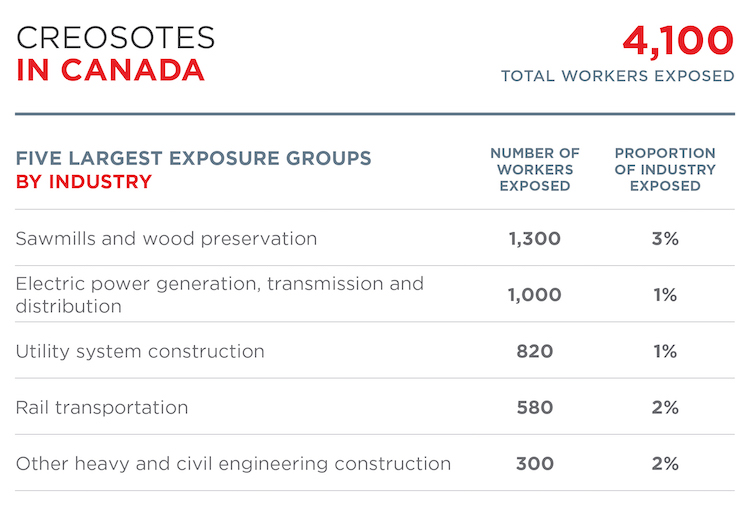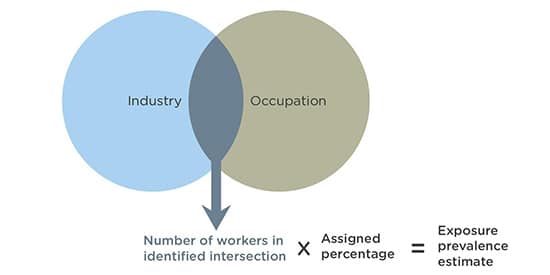Creosotes Occupational Exposures

CONTENTS
Creosotes Occupational Exposures
Overview
The most important routes of occupational exposure to creosotes are inhalation and dermal.[1] CAREX Canada estimates that approximately 4,100 Canadians are exposed to creosotes in their workplace.
READ MORE...
The primary industrial groups exposed are within the sawmill and wood preservation industry and electric power generation (transmission and distribution). Other important exposed groups include utility system construction and rail transportation.
The occupational groups with the largest numbers of workers exposed include: construction trades helpers and labourers, electrical power line and cable workers, labourers in wood, pulp and paper processing, and railway yard and track maintenance workers. Other occupations that may also be exposed include fence and bridge construction workers and site remediation workers.[2]
According to the Burden of Occupational Cancer in Canada project, occupational exposure to creosotes leads to possibly 95 non-melanoma skin cancers each year in Canada, based on past exposures (1961-2001). [3,4] This amounts to 0.1% of all non-melanoma skin cancers diagnosed annually. Most cancers related to creosotes occur among workers in the manufacturing, transportation & warehousing, and construction sectors.[4]
Prevalence Estimate
Results show that approximately 4,100 Canadians are exposed to creosotes in their workplaces; 94% of these workers are male. The largest industrial groups exposed include sawmills and wood preservation, electric power generation (transmission and distribution), utility system construction, and rail transportation.
The occupational groups with the largest numbers of workers exposed include construction trades helpers and labourers (910 workers exposed), electrical power line and cable workers (780 workers exposed), labourers in wood, pulp and paper processing (670 workers exposed), and railway yard and track maintenance workers (410 workers exposed).
The number of workers exposed to creosotes decreased by approximately 690 workers from 2006 to 2016 (a 14% decrease). This was primarily driven by decreases in the total number of labourers in wood, pulp and paper processing and lumber graders and other wood processing inspectors and graders.
Workers exposed to creosotes by industry in 2016

Workers exposed to creosotes by region in 2016
Click the second tab to view total number of workers exposed.
* = < 50 workers
Methods and Data
Our Occupational Approach page outlines the general approach used to calculate prevalence and exposure level estimates for workplace exposures.
Data Sources
Data used in developing the occupational estimates for creosotes were collected from several sources:
- Canadian and US scientific peer reviewed publications that addressed creosote exposure in Canada and the United States.
- Grey literature including technical reports from governments and international bodies.
Prevalence Estimate Method
CAREX defines exposure to creosotes as the potential for inhalation or dermal contact with creosotes at work at levels exceeding those encountered in non-occupational settings.
To determine the number of workers potentially exposed to creosotes at work, CAREX occupational exposure experts used methods previously established in other peer-reviewed CAREX projects in Europe. A series of steps were taken to assign exposure proportions to occupations and industries at risk of exposure to creosotes.

- Occupations and industries at risk of possible exposure to creosotes were identified using any combination of data sources described above.
- The total number of workers in each identified occupation and industry intersection was obtained from Statistics Canada 2016 census data.
- A percentage of workers exposed was assigned to that occupation and industry intersection. Percentages were determined by consultation with existing evidence in the data sources, previously established methods from the Europe CAREX estimates and the expert judgement of CAREX occupational hygienists.
- The number of workers in the identified group is multiplied by the assigned percentage to calculate the prevalence estimate of workers exposed to creosotes.
Sources
Subscribe to our newsletters
The CAREX Canada team offers two regular newsletters: the biannual e-Bulletin summarizing information on upcoming webinars, new publications, and updates to estimates and tools; and the monthly Carcinogens in the News, a digest of media articles, government reports, and academic literature related to the carcinogens we’ve classified as important for surveillance in Canada. Sign up for one or both of these newsletters below.
CAREX Canada
School of Population and Public Health
University of British Columbia
Vancouver Campus
370A - 2206 East Mall
Vancouver, BC V6T 1Z3
CANADA
As a national organization, our work extends across borders into many Indigenous lands throughout Canada. We gratefully acknowledge that our host institution, the University of British Columbia Point Grey campus, is located on the traditional, ancestral and unceded territories of the xʷməθkʷəy̓əm (Musqueam) people.


